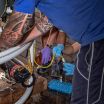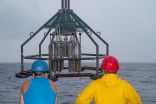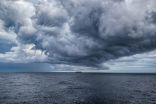
With the RV SONNE to the South China Sea: Research in a natural laboratory under climatic and anthropogenic stress
07.08.2019 – Science has started
In the early morning of August 6, we reached the study area and our first sampling station. Our work started – like always at a new station – with the deployment of the CTD with the water sampler rosette, because we need to know more about the properties of the water column beneath the RV SONNE to plan our sampling. On the way down – here it was about 1900 metres to the seafloor –, the CTD sensors measure temperature, salinity, dissolved oxygen, chlorophyll a, turbidity and a few other parameters. The data are transmitted directly to the ship, where the depth profiles of all measurements can be viewed immediately. When the CTD has reached the bottom, we use the profiles to jointly decide, at which depths the instrument should stop on its way up to take water samples that suit our respective research objectives. Once the CTD is back on board, everyone flocks around to get their samples. A stringent plan is necessary to ensure that the water is tapped in the right order and that everyone gets the water volume necessary for their work.
Once the water samples are on board, the next step was to sample the ocean floor. For this we have a "Multi-Corer" (MUC for short) on board, which can pull eight half-metre sediment cores at once. When the MUC is back on board, the sample tubes must be carefully removed so that no sample is lost – a tricky business anyway that doesn't get any easier when a heavy tropical rain pores down. But even in such downpours it remains warm and fortunately the weather changes quickly, so that it usually clears up pretty soon and we can once more enjoy blue skies with circling seabirds.
(Photos: IOW / R. Prien, please click for a larger view)
| Expedition: | SO269 |
| Project: | MEGAPOL |
| Start: | 31.07.2019 - Singapur |
| Destination: | 03.09.2019 - Hong Kong |





